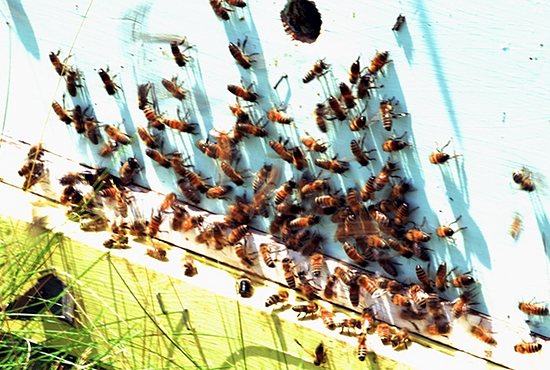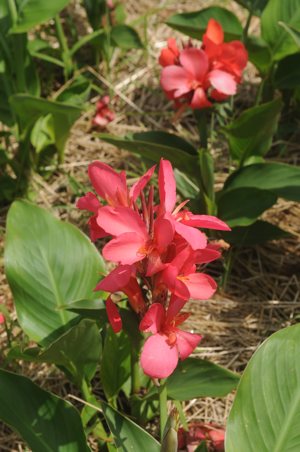Rosemount parish brings bees to community garden

On any given day, volunteers work like busy bees in the Matthew 25 community garden at St. Joseph in Rosemount.
But since July 6, actual honeybees have taken over some of the work, helping the garden to grow more and better vegetables and flowers.
This is the second summer for the garden, named for verses 21 to 40 of Matthew 25, where taking care of God’s creation, feeding the hungry and visiting the sick are specifically mentioned. The passage gives the garden its purpose.
“It has two specific missions,” said Father Paul Jarvis, pastor of St. Joseph. “First is to provide food for the homeless through the Loaves and Fishes Program and Ministry or through the local food shelf. The other thing is there are a lot of people that can’t garden, can’t get flowers, can’t get out of their house. We bring flowers to them.”
The idea for bringing the honeybees to the garden came to Father Jarvis after he read a newspaper article about Colony Collapse Disorder, the reason for the decrease in bee populations worldwide.
 “The name is simple, but the problem is so complex,” said entomologist Becky Masterman, associate program director of the Bee Squad at the University of Minnesota, Twin Cities campus.
“The name is simple, but the problem is so complex,” said entomologist Becky Masterman, associate program director of the Bee Squad at the University of Minnesota, Twin Cities campus.
Bees play an important role in agricultural production and the beauty of the world through the pollination of fruits, vegetables, nuts and flowers. The decrease in the number of bees is starting to have a visible impact.
How you can helpPlant bee flowers: Bees get carbohydrates from floral nectar, and protein from floral pollen. There are many flowers in Minnesota that bees like. Visit the University of Minnesota’s Bee Lab at beelab.umn.edu, and click Plants for Minnesota Bees in the right column.
Provide a nesting habitiat: Most bees like dry, sandy, bare soil, so leaving spots of exposed soil in your yard can attract bees. Some bees like to nest in hollow plant stems or holes in wood. You can attract cavity-nesting bees by providing tunnels in a hand-made structure called a bee house — like a bird house for bees.
Reduce or eliminate pesticide use
“With all the research that scientists have done, our understanding is that it’s a health crisis that’s caused by multiple factors,” Masterman said.
Pathogens, poor nutrition and pesticides are among those factors. Since 2006, one out of three honeybee colonies has been lost each winter, Masterson said.
 “The beekeepers won’t have enough bees to pollinate, so that means that we’ll have lower crop yields that will translate into fewer choices at the supermarket and more processed food. That’s how it will really impact us,” Masterman said.
“The beekeepers won’t have enough bees to pollinate, so that means that we’ll have lower crop yields that will translate into fewer choices at the supermarket and more processed food. That’s how it will really impact us,” Masterman said.
As suburban communities spread out, bees suffer because there are fewer flowering plants to provide them with nutrition. The chemicals used to eliminate weeds from yards are bad for the bees. And, some of those weeds are actually flowering plants that are good food for bees.
“It shows that what we’re doing so that our landscaping looks really pristine is getting into the food of the bees,” Masterman said.
Planting bee-friendly flowers is one thing people can do to help. Bees get carbohydrates from floral nectar, and protein from floral pollen. There are many flowers in Minnesota that bees like, sunflowers for example.
“Seriously, our farmers, our economy here in Minnesota depend on it. Our gardens depend on it. Our beautiful flowering plants and trees depend on it,” Father Jarvis said. “If everybody steps up to the plate, then we can start making a dent in a really critical situation.”
Parishioner Craig Francois, general contractor and part-time beekeeper, is doing his part. He donated and takes care of the hive, which is situated a few yards away from the parish’s garden.
He, too, became interested in saving bees after reading about Colony Collapse Disorder.

“I thought, that’s something I can do,” he said. “I decided to look into this honeybee business and hives, and I took the class at the University of Minnesota in March, four years ago. It was so interesting, I went home and ordered three hives just like that.”
Francois now has seven hives he keeps on a family farm in Iowa. He travels there often to tend to them.
“They are very efficient. Have you ever watched a bee work? I mean, it’s going from flower, to flower, to flower, to flower. It’s fun to watch them,” he said.
His daughter Rebecca, a recent graduate of St. Joseph School, also will help take care of them and will help teach second-graders at the school about the bees as part of an insect unit in science class. He hopes she will be an example for them.
“With Rebecca not afraid of the bees, hopefully the young students will respect and help protect the bees and all insects,” he said.
Did you know?St. Ambrose is the patron saint of bees, beekeepers and candle makers. According to legend, while an infant, a swarm of bees settled on his face while he lay in his cradle, leaving behind a drop of honey. His father considered this a sign of his future eloquence and honeyed tongue. For this reason, bees and beehives often appear in the saint’s symbology.
Source: Catholic Online
“The biggest work is if you’re harvesting honey,” he said. He plans to have students help with that. “It’s a fun day,” he said.
Bees will travel two to three miles to get food, pollinating plants in other gardens and local farms.
“The bee hive we’ve introduced will not only harbor critically needed pollinators for our Matthew 25 Garden,” Father Jarvis said, “[but it also] will provide pollinators for miles around. Research reveals that, actually, other farms and gardens will benefit more than our very own garden.”
Having the bees near the parish’s Matthew 25 Garden is helping raise awareness of the bee problem by spreading the word to parishioners.
“They’re inviting them to be invested in their health and survival,” Masterman said.
“I think one of the things to keep in mind, at least, is that ultimately, we are stewards of God’s creation,” Father Jarvis said. “What we have, we are given for a period of time. We were to take care of it for God and for his people, and so this is a significant step in that direction.”



